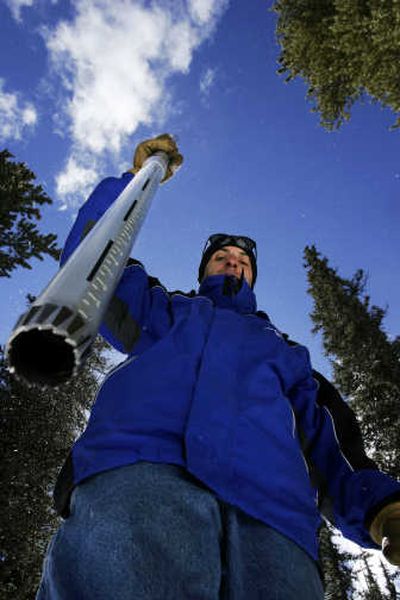Wet winter will slake thirsty West

GRANT, Colo. – Natural Resources Conservation Service hydrologist Joe Messina pushes an aluminum tube straight down into the spongy springtime snow in a mountainside forest, crouches to read the markings on the side and calls out the depth: 28 inches.
He and partner Chris Pacheco weigh the snow captured in the tube, and Pacheco enters the result into his calculator. It returns good news: The snow in this remote area is the equivalent of a 6 ½-inch layer of water, well above average.
Across the West this spring, the picture is similar, with abundant mountain snow in most areas promising runoff that will provide a break from the drought that has sporadically parched the region since late 1999.
The Colorado mountains are poised to unleash more runoff than they have in 11 years. Streams in Washington and Oregon are forecast to carry up to 50 percent more water than usual. Lake Powell, stretching more than 100 miles across Utah and Arizona, is expected to rise 50 feet from its current depleted state.
“Overall, the entire West looks pretty good, Colorado and the Pacific Northwest in particular,” said Tom Perkins, a senior hydrologist with the National Water and Climate Center in Portland. “There’s no part of the West that’s really what you’d call hurting.”
This winter was the region’s wettest since 2004-‘05.
It’s rare for the entire region’s mountains to enjoy a wet winter at the same time, said Doug LeComte, a drought specialist for the National Oceanic and Atmospheric Administration in Camp Springs, Md.
“Usually there’s a separation between the northern part of the West and the southern part of the West. One is usually very wet and one is very dry. That dichotomy went away this winter,” he said.
The reason was an unusually strong jet stream – it was “on steroids,” LeComte said – that pushed this past winter’s storms across more of the West than expected. Cold weather helped by allowing the snow to build up instead of melting away rapidly, Perkins said.
The results are showing up at some 3,000 snow-measuring sites in 12 states monitored by the federal Natural Resources Conservation Service.
The measurements gathered by Messina and Pacheco in the Pike National Forest, about 40 miles southwest of Denver, became part of a monthly Snow Survey report that showed Colorado’s snowpack was 23 percent above average statewide, and as much as 41 percent above average in some places. It had been even higher a month before – 35 percent above average statewide – before dry weather in March.
“This is the best year we’ve got for runoff (in Colorado) in 11 years,” said Mike Gillespie, the Snow Survey supervisor in Denver.
The consequences are far-reaching. More than a half-dozen significant rivers originate in the Colorado mountains and flow through at least 10 other states and Mexico. The water is divvied up under nine interstate compacts, three U.S. Supreme Court decrees and two international treaties.
One of those rivers, the Colorado, flows into Lake Powell behind Glen Canyon Dam, a key link in the complicated and often contentious system that stores and dispenses the river’s water.
Lake Powell was full in 1999 but has fallen 100 feet because some of those agreements required that more water be delivered to Mexico and downriver states than the river brought in.
For the first time since 2003, the lake will be high enough to let boaters pass through a formation called the Castle Rock cut, lopping 12 miles off the voyage from the southern end of the lake to the northern.
Deeper water in Lake Powell and other reservoirs also helps the federal Bureau of Reclamation’s hydroelectric plants run more efficiently, and they’re projected to crank out 400 million more kilowatt-hours this year than last, an increase of up to 8 percent and enough to power 33,000 homes for a year, spokeswoman Lisa Iams said.
Forecasters say the threat of floods caused by the melting snow is still unclear.
They are reluctant to say whether the deep snow signals the end of the drought or is just another interruption.
“I’m afraid variability is kind of normal in the West,” Le Comte said.